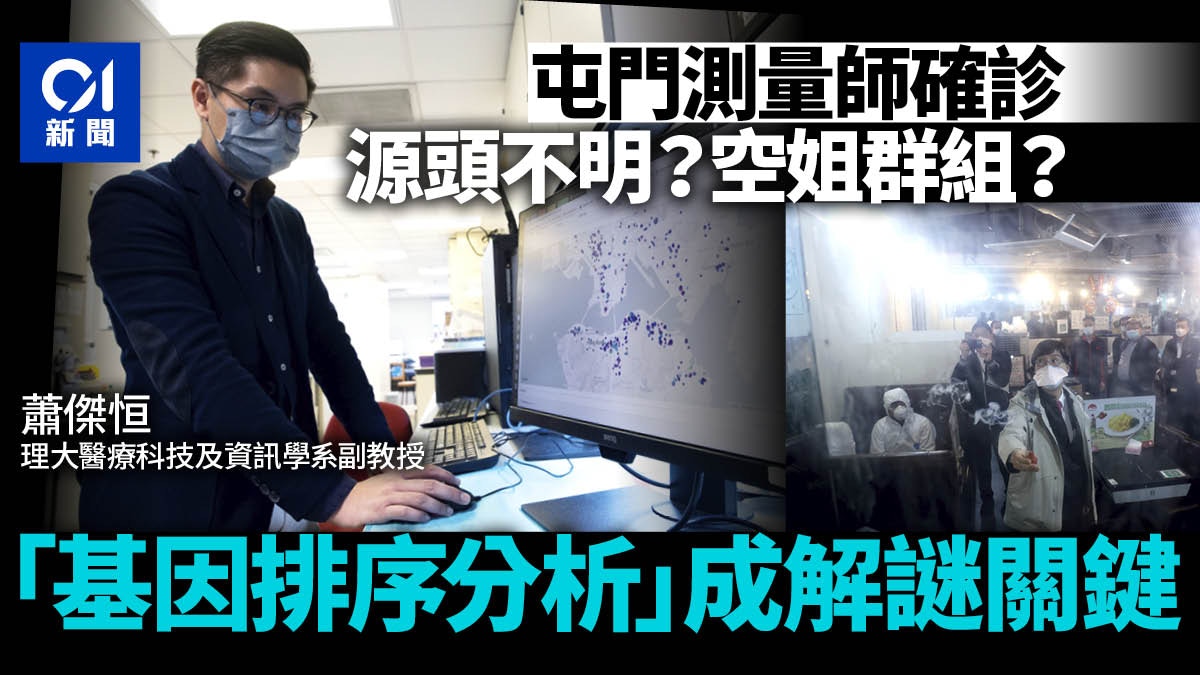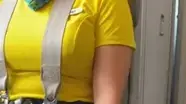The "Genetic Sequencing Analysis" of the new coronavirus has become indispensable information for understanding the fifth wave of the epidemic. It can be used to trace the source of infection of a case, and to understand whether the case involves the same group. However, the team behind the epidemic is not necessarily familiar. Behind the complicated tests, few people know what "gene sequencing analysis" actually is.
One of them is the team led by Associate Professor Xiao Jieheng of the Department of Health Technology and Informatics of PolyU. Since the first wave of the epidemic, PolyU has begun to analyze cases by genetic sequencing to understand the source of infection behind each case.
Since the outbreak of the fifth wave, Xiao Jieheng's team has analyzed almost every case.
Among them, it was the first to find out that the unknown source case was related to the flight attendant group by genetic sequencing. It was revealed that the case was infected because he had been to the chef of Lu Tianyuan restaurant at the same time as the confirmed patient, which helped the authorities to track the confirmed cases of Lu Tianyuan step by step.
Xiao said bluntly, "This one is about speed and slowness. If there is a result before sunrise, the investigation direction will be different that day."
[Second of a series of reports on the second anniversary of the anti-epidemic]
Extended reading: Two years of anti-epidemic | The fifth wave of Omicron and Delta's attack from external defense imports (review of one article)
The team led by Associate Professor Xiao Jieheng of the Department of Health Technology and Informatics of the Polytechnic University began to collect samples from the first wave of the epidemic and analyze the genes of the cases to trace the source of infection.
(Photo by Luo Junhao)
Xiao Jieheng is a medical laboratory technician. He said with a smile that he started studying laboratory tests, but because of his poor grades in the examinations, and the admission requirements for laboratory tests were not high, he randomly chose to study in the subject, and later he had a new understanding of medical laboratory tests while reading. awareness.
However, the year of graduation was after SARS in 2003. At that time, the public medical and health system had not yet been reformed, and laboratory technicians were not a popular job.
He decided to further study and then joined the laboratory.
Over the years of his research career, he began to love the development of new detection methods, hoping to speed up the diagnosis process of patients.
When the epidemic hits, I consciously become an "air-conditioned military strategist" thinking about genetic sorting to make a contribution
After joining PolyU, Xiao Jieheng's team has been conducting genetic analysis of different infectious diseases in the past, such as tuberculosis and AIDS, and has always focused on the genetic research of drug resistance.
In January two years ago, the first outbreak of the new crown occurred in Hong Kong. "At that time, I heard that many hospital colleagues and students were working hard and nervous on the front line, and the social atmosphere was very bad. I was like an air-conditioned military sergeant. So good."
So, he began to think about how, as a medical laboratory technician, he could contribute to the epidemic and study whether the gene analysis technology could be applied to the genetic research of the new coronavirus.
In the early days of the epidemic, he noticed that the social atmosphere was poor, and he consciously became an "air-conditioning strategist", thinking about how genetic analysis could help fight the epidemic.
(Photo by Luo Junhao)
Gene citation ranking of cases analyzed since two years ago can determine whether cases are related
However, due to the initial stage of the new crown epidemic in Hong Kong, mainly imported cases, the analysis of gene sequencing has been carried out by the Public Health Laboratory of the Centre for Health Protection, so the team has not had the opportunity to conduct sample analysis.
Until February 2020, some of the gene sequencing samples were shunted to public hospitals. Xiao pointed out that since PolyU would cooperate with hospital laboratories from time to time, he decided to seize the opportunity and use nucleic acid samples for research at the invitation of the hospital.
Everything is always difficult at the beginning. "At that time, most of the research funds were used for other infectious diseases, so I wrote a short three-page proposal than the head of the department." Unexpectedly, the three-page proposal actually brought him 1 million yuan. The funding also lays the foundation for the future genetic sequencing and analysis of the new crown epidemic.
He said with a smile that at that time the laboratory had insufficient resources and had to do everything by himself.
Recalling the day I received the grant, I went to the gold mall with my colleagues to buy computer accessories "Building Machines".
After several twists and turns, the nucleic acid sample of the case was finally obtained the next day, and the test was analyzed in different ways.
After repeated attempts and comparisons of various groups, it was found that by analyzing the similarity of gene sequences, it was possible to determine whether the cases were related, and to track the transmission route of the virus.
However, as the CHP does not cooperate directly with the Polytechnic University, it is not easy to obtain samples from confirmed cases.
Xiao described the related work as a test of the team's initiative. "No one will regularly compare the samples to us. It's up to me to carry out and ask questions."
During the visit, it was during the government's press conference on the epidemic. Xiao also kept an eye on the phone from time to time to check the latest development of the epidemic.
He revealed that in the early stage of the epidemic, the team needed to pay attention to the epidemic press conference every day, and then copied down the details of the case, and estimated that the hospital where the case was admitted should "ask (and take samples) and do it slowly", and watch the epidemic situation at 4:30 every day. become his habit.
Tried the black rain and went to the hospital to get samples, hoping to help trace the source of the case as soon as possible
Hsiao said that after the release of the first analysis report, public hospitals began to build confidence in the PolyU team's research, and hospitals were more willing to submit case samples to PolyU for genetic sequencing analysis.
Although the Department of Health has not played a coordinating role until the fifth wave of the epidemic, he said that the current communication mechanism is better than that of the first few waves. .
For more urgent cases, the CHP will also proactively contact PolyU to provide the patient's admission number, and then the PolyU team will send someone to the hospital to collect patient samples.
Since the fifth wave of the epidemic, preliminary positive cases have been added every day, which means that the team needs to send people to public hospitals to collect nucleic acid samples every day. Xiao also pointed out that the team has tried to rush to the hospital to collect samples in the dark rain and early morning hours. .
No fear of wind and rain, day and night, the All-Cause team hopes to complete the genetic sequencing as soon as possible to help trace the source of the case.
One-night analysis found that unknown cases who visited Lvtianyuan belonged to the same group as flight attendants
During the interview, he explained that the nucleic acid samples of confirmed patients can be analyzed systematically after testing, and it takes nearly eight hours to analyze the genetic sequence of each case.
The system will display the relationship between cases in tree branches. If they belong to the same group, they will be displayed on the same branch. However, if there are several mutations in the sorting, or they are not on the same branch, it means that the cases are not related.
Siu Kit-hang took a 42-year-old surveyor who was diagnosed earlier and lived in Tuen Mun as an example. He pointed out that the patient was first listed as a case of unknown origin at that time. Later, he was found to live across the river from the Cathay Pacific pilot in the Wangyuelou group. It has always been thought that the case is related to the invisible transmission chain in Tuen Mun.
Until the team conducted genetic sequencing analysis overnight that night, Fang discovered that the case sequencing was related to the flight attendant group, and then found that he had visited the chef of the Green Garden Restaurant to help the authorities track the confirmed cases of Lu Tianyuan step by step, "This one is about speed and slowness. , if there is a result before sunrise, the direction of the investigation will be different that day.”
▼1.5 Department of Health to DIVA Lutianyuan Restaurant Chef Survey▼
+11
Although he has analyzed wave after wave of epidemics, Xiao Jieheng pointed out that in the past, only samples from infected groups were used for analysis, but the biggest difference in the fifth wave of epidemics is that the team will analyze each case, including imported cases, from To make it easier to compare which cases brought the virus into the community, triggering a chain of transmission.
He bluntly said that the work at this stage is the most unforgettable since the two years of the epidemic, "I haven't tried to do so many cases, I haven't tried but I haven't stopped, so I think I can stop after finishing one, and then I get a call to do another one. ”, the team worked all night, and even in the early morning, even though the process was arduous, it also gave him an incomparable sense of satisfaction.
Xiao Jieheng, who has three children, admitted that he has sacrificed a lot of personal time for the epidemic in the past two years, and his daily life revolves around work, genetic sequencing analysis, and "getting together".
He pointed out that because of the epidemic, he basically lost all his personal time.
However, I emphasize that I am not an isolated example, and many frontline medical staff also work hard every day.
When asked about his outlook for the future, his wish is the same as that of the general public, and he does not want the next wave of the epidemic: "At the beginning (the epidemic) thought it was an opportunity to let the team know, but every time the result comes out, I hope it will come soon. Do the analysis, it’s a low thing, I really don’t want to have another wave of epidemics.” I most hope that children can return to normal life, “As soon as children are born, they must wear masks when they go out to the street, be careful, and if you want to return to the normal world, then It's not like they listen to the normal world."
Omicron|Chen Heng-pin visited Tsuen Wan, Kwai Chung to inspect the whole village of Kwai Chung Village Omicron|The virus’s lifespan is prolonged due to the cold, and the risk of infection increases Requirement to be arrested by the police to fight the epidemic for two years |









